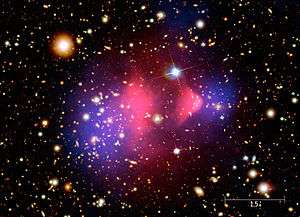XENON
The XENON dark matter research project, operated at the Italian Gran Sasso National Laboratory, is a deep underground research facility featuring increasingly ambitious experiments aiming to detect dark matter particles. The experiments aim to detect particles in the form of weakly interacting massive particles (WIMPs) by looking for rare interactions via nuclear recoils in a liquid xenon target chamber. The current detector consists of a dual phase time projection chamber (TPC).
The experiment detects scintillation and ionization produced when particles interact in the liquid xenon volume, to search for an excess of nuclear recoil events over known backgrounds. The detection of such a signal would provide the first direct experimental evidence for dark matter candidate particles. The collaboration is currently led by Italian professor of physics Elena Aprile from Columbia University.
Detector principle
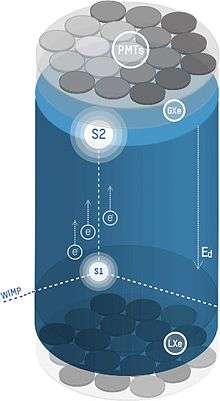
The XENON experiment operates a dual phase time projection chamber (TPC), which utilizes a liquid xenon target with a gaseous phase on top. Two arrays of photomultiplier tubes (PMTs), one at the top of the detector in the gaseous phase (GXe), and one at the bottom of the liquid layer (LXe), detect scintillation and electroluminescence light produced when charged particles interact in the detector. Electric fields are applied across both the liquid and gaseous phase of the detector. The electric field in the gaseous phase has to be sufficiently large to extract electrons from the liquid phase.
Particle interactions in the liquid target produce scintillation and ionization. The prompt scintillation light produces 178 nm ultraviolet photons. This signal is detected by the PMTs, and is referred to as the S1 signal. This technique has proved sensitive enough to detect single photoelectrons.[1] The applied electric field prevents recombination of all the electrons produced from a charged particle interaction in the TPC. These electrons are drifted to the top of the liquid phase by the electric field. The ionization is then extracted into the gas phase by the stronger electric field in the gaseous phase. The electric field accelerates the electrons to the point that it creates a proportional scintillation signal that is also collected by the PMTs, and is referred to as the S2 signal.
The detector allows for a full 3-D position determination[2] of the particle interaction. Electrons in liquid xenon have a uniform drift velocity. This allows the interaction depth of the event to be determined by measuring the time delay between the S1 and S2 signal. The position of the event in the x-y plane can be determined by looking at the number of photons seen by each of the individual PMTs. The full 3-D position allows for the fiducialization of the detector, in which a low-background region is defined in the inner volume of the TPC. This fiducial volume has a greatly reduced rate of background events as compared to regions of the detector at the edge of the TPC, due to the self-shielding properties of liquid xenon. This allows for a much higher sensitivity when searching for very rare events.
Charged particles moving through the detector are expected to either interact with the electrons of the xenon atoms producing electronic recoils, or with the nucleus, producing nuclear recoils. For a given amount of energy deposited by a particle interaction in the detector, the ratio of S2/S1 can be used as a discrimination parameter to distinguish electronic and nuclear recoil events.[3] This ratio is expected to be greater for electronic recoils than for nuclear recoils. In this way backgrounds from electronic recoils can be suppressed by more than 99%, while simultaneously retaining 50% of the nuclear recoil events.
XENON10
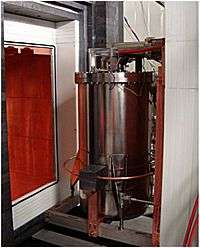
The XENON10 experiment was installed at the underground Gran Sasso laboratory in Italy during March 2006. The underground location of the laboratory provides 3100 m of water-equivalent shielding. The detector was placed within a shield to further reduce the background rate in the TPC. XENON10 was intended as a prototype detector, to prove the efficacy of the XENON design, as well as verify the achievable threshold, background rejection power and sensitivity. The XENON10 detector contained 15 kg of liquid xenon. The sensitive volume of the TPC measures 20 cm in diameter and 15 cm in height.[4]
An analysis of 59 live days of data, taken between October 2006 and February 2007, produced no WIMP signatures. The number of events observed in the WIMP search region is statistically consistent with the expected number of events from electronic recoil backgrounds. This result excluded some of the available parameter space in minimal Supersymmetric models, by placing limits on spin independent WIMP-nucleon cross sections down to below 10×10−43 cm2 for a 30 GeV/c2 WIMP mass.[5]
Due to nearly half of natural xenon having odd spin states (129Xe has an abundance of 26% and spin-1/2; 131Xe has an abundance of 21% and spin-3/2), the XENON detectors can also be used to provide limits on spin dependent WIMP-nucleon cross sections for coupling of the dark matter candidate particle to both neutrons and protons. XENON10 set the world's most stringent restrictions on pure neutron coupling.[6]
XENON100
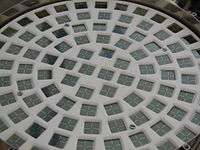
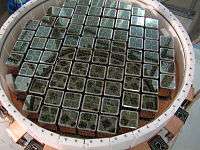
The second phase detector, XENON100, contains 165 kg of liquid xenon, with 62 kg in the target region and the remaining xenon in an active veto. The TPC of the detector has a diameter of 30 cm and a height of 30 cm. As WIMP interactions are expected to be extremely rare events, a thorough campaign was launched during the construction and commissioning phase of XENON100 to screen all parts of the detector for radioactivity. The screening was performed using high-purity Germanium detectors. In a few cases mass spectrometry was performed on low mass plastic samples. In doing so the design goal of <10−2 events/kg/day/keV [7] was reached, realising the world's lowest background rate dark matter detector.
The detector was installed at the Gran Sasso National Laboratory in 2008 in the same shield as the XENON10 detector, and has conducted several science runs. In each science run, no dark matter signal was observed above the expected background, leading to the most stringent limit on the spin independent WIMP-nucleon cross section in 2012, with a minimum at 2.0×10−45 cm2 for a 65 GeV/c2 WIMP mass.[8] These results constrain interpretations of signals in other experiments as dark matter interactions, and rule out exotic models such as inelastic dark matter, which would resolve this discrepancy.[9] XENON100 has also provided improved limits on the spin dependent WIMP-nucleon cross section.[10] An axion result was published in 2014,[11] setting a new best axion limit.
XENON100 operated the then-lowest background experiment, for dark matter searches, with a background of 50 mDRU (1 mDRU=10−3 events/kg/day/keV).[12]
XENON1T
Construction of the next phase, XENON1T, started in Hall B of the Gran Sasso National Laboratory in 2014. The detector contains 3.2 tons of ultra radio-pure liquid xenon, and has a fiducial volume of about 2 tons. The detector is housed in a 10 m water tank that serves as a muon veto. The TPC is 1 m in diameter and 1 m in height.
The detector project team, called the XENON Collaboration, is composed of 135 investigators across 22 institutions from Europe, the Middle East, and the United States.[13]
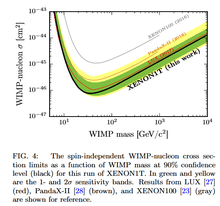
The first results from XENON1T were released by the XENON collaboration on May 18, 2017, based on 34 days of data-taking between November 2016 and January 2017. While no WIMPs or dark matter candidate signals were officially detected, the team did announce a record low reduction in the background radioactivity levels being picked up by XENON1T. The exclusion limits exceeded the previous best limits set by the LUX experiment, with an exclusion of cross sections larger than 7.7×10−47 cm2 for WIMP masses of 35 GeV/c2.[14][15] Because some signals that the detector receives might be due to neutrons, reducing the radioactivity increases the sensitivity to WIMPs.[16]
In September 2018 the XENON1T experiment published its results from 278.8 days of collected data. A new record limit for WIMP-nucleon spin-independent elastic interactions was set, with a minimum of 4.1×10−47 cm2 at a WIMP mass of 30 GeV/c2.[17]
In April 2019, based on measurements performed with the XENON1T detector, the XENON Collaboration reported in Nature the first direct observation of two-neutrino double electron capture in xenon-124 nuclei.[18] The measured half-life of this process, which is several orders of magnitude larger than the age of the Universe, demonstrates the capabilities of xenon-based detectors to search for rare events and showcases the broad physics reach of even larger next-generation experiments. This measurement represents a first step in the search for the neutrinoless double electron capture process, the detection of which would provide valuable insight into the nature of the neutrino and allow to determine its absolute mass.
As of 2019, the XENON1T experiment has stopped data-taking to allow for construction of the next phase, XENONnT.[19]
In June 2020, the XENON1T collaboration reported an excess of electron recoils: 285 events, 53 more than the expected 232.[20][21] Three explanations were considered: existence of to-date-hypothetical solar axions, a surprisingly large magnetic moment for neutrinos, and tritium contamination in the detector. There is insufficient data to choose among these three, though the XENONnT upgrade should provide this capacity.
XENONnT
XENONnT is an upgrade of the XENON1T experiment underground at LNGS. Its systems will contain a total xenon mass of more than 8 tonnes. Apart from a larger xenon target in its time projection chamber the upgraded experiment will feature new components to further reduce or tag radiation that otherwise would constitute background to its measurements. It is designed to reach a sensitivity (in a small part of the mass-range probed) where neutrinos become a significant background. As of 2019, the upgrade is on-going and first light is expected in 2020.[22][23]
References
- Aprile, E.; et al. (XENON100 Collaboration) (2014). "Observation and applications of single-electron charge signals in the XENON100 experiment". Journal of Physics G. 41 (3): 035201. arXiv:1311.1088. Bibcode:2014JPhG...41c5201A. doi:10.1088/0954-3899/41/3/035201.
- Aprile, E.; et al. (XENON100 Collaboration) (2012). "The XENON100 dark matter experiment". Astroparticle Physics. 35 (9): 573–590. arXiv:1107.2155. Bibcode:2012APh....35..573X. CiteSeerX 10.1.1.255.9957. doi:10.1016/j.astropartphys.2012.01.003.
- Aprile, E.; et al. (2014). "Analysis of the XENON100 dark matter search data". Astroparticle Physics. 54: 11–24. arXiv:1207.3458. Bibcode:2014APh....54...11A. doi:10.1016/j.astropartphys.2013.10.002.
- Aprile, E.; et al. (XENON10 Collaboration) (2011). "Design and Performance of The XENON10 Experiment". Astroparticle Physics. 34 (9): 679–698. arXiv:1001.2834. Bibcode:2011APh....34..679A. doi:10.1016/j.astropartphys.2011.01.006.
- Angle, J.; et al. (XENON10 Collaboration) (2008). "First Results from the XENON10 Dark Matter Experiment at the Gran Sasso National Laboratory". Physical Review Letters. 100 (2): 021303. arXiv:0706.0039. Bibcode:2008PhRvL.100b1303A. doi:10.1103/PhysRevLett.100.021303. PMID 18232850.
- Angle, J.; et al. (XENON10 Collaboration) (2008). "Limits on spin-dependent WIMP-nucleon cross-sections from the XENON10 experiment". Physical Review Letters. 101 (9): 091301. arXiv:0805.2939. Bibcode:2008PhRvL.101i1301A. doi:10.1103/PhysRevLett.101.091301. PMID 18851599.
- Aprile, E.; et al. (XENON100 Collaboration) (2011). "Material screening and selection for XENON100". Astroparticle Physics. 35 (2): 43–49. arXiv:1103.5831. Bibcode:2011APh....35...43A. doi:10.1016/j.astropartphys.2011.06.001.
- Aprile, E.; et al. (XENON100 Collaboration) (2012). "Dark Matter Results from 225 Live Days of XENON100 Data". Physical Review Letters. 109 (18): 181301. arXiv:1207.5988. Bibcode:2012PhRvL.109r1301A. doi:10.1103/physrevlett.109.181301. PMID 23215267.
- Aprile, E.; et al. (XENON100 Collaboration) (2011). "Implications on inelastic dark matter from 100 live days of XENON100 data". Physical Review D. 84 (6): 061101. arXiv:1104.3121. Bibcode:2011PhRvD..84f1101A. doi:10.1103/PhysRevD.84.061101.
- Aprile, E.; et al. (XENON100 Collaboration) (2012). "Limits on spin-dependent WIMP-nucleon cross sections from 225 live days of XENON100 data". Physical Review Letters. 111 (2): 021301. arXiv:1301.6620. Bibcode:2013PhRvL.111b1301A. doi:10.1103/PhysRevLett.111.021301. PMID 23889382.
- Aprile, E.; et al. (XENON1000 Collaboration) (2014). "First Axion Results from the XENON100 Experiment". Physical Review D. 90 (6): 062009. arXiv:1404.1455. Bibcode:2014PhRvD..90f2009A. doi:10.1103/PhysRevD.90.062009.
- Aprile, E.; et al. (XENON100 Collaboration) (2011). "Study of the electromagnetic background in the XENON100 experiment". Physical Review D. 83 (8): 082001. arXiv:1101.3866. Bibcode:2011PhRvD..83h2001A. doi:10.1103/physrevd.83.082001.
- "Homepage of the XENON1T Dark Matter Search". http://www.xenon1t.org. Retrieved 2017-06-02. External link in
|website=(help) - Aprile, E.; et al. (XENON collaboration) (2017). "First Dark Matter Search Results from the XENON1T Experiment". Physical Review Letters. 119 (7679): 153–154. arXiv:1705.06655. Bibcode:2017Natur.551..153G. doi:10.1038/551153a. PMID 29120431.
- "The World's Most Sensitive Dark Matter Detector Is Now Up and Running". May 24, 2017. Retrieved May 25, 2017.
- "World's most sensitive dark matter detector releases first results". UChicago News. 2017-05-18. Retrieved 2017-05-29.
- Aprile, E.; et al. (XENON collaboration) (2018). "Dark Matter Search Results from a One Ton-Year Exposure of XENON1T". Physical Review Letters. 121 (11): 111302. arXiv:1805.12562. Bibcode:2018PhRvL.121k1302A. doi:10.1103/PhysRevLett.121.111302. PMID 30265108.
- Suhonen, Jouni (2019). "Dark-matter detector observes exotic nuclear decay". Nature. 568 (7753): 462–463. Bibcode:2019Natur.568..462S. doi:10.1038/d41586-019-01212-8. PMID 31019322.
- url=http://www.lowbg.org/ugnd/workshop/sympo_all/201903_Sendai/slides/8am/8am_6.pdf
- Aprile, E.; et al. (2020-06-17). "Observation of Excess Electronic Recoil Events in XENON1T". arXiv: 2006.09721v1.
- Wolchover, Natalie (2020-06-17). "Dark Matter Experiment Finds Unexplained Signal". Quanta Magazine. Retrieved 2020-06-18.
- http://www.lowbg.org/ugnd/workshop/sympo_all/201903_Sendai/slides/8am/8am_6.pdf
- "scanR | Moteur de la Recherche et de l'Innovation". scanr.enseignementsup-recherche.gouv.fr (in French). Retrieved 2020-06-30.
Further reading
- Angle, J; et al. (2008). "First Results from the XENON10 Dark Matter Experiment at the Gran Sasso National Laboratory". Physical Review Letters. 100 (2): 021303. arXiv:0706.0039. Bibcode:2008PhRvL.100b1303A. doi:10.1103/PhysRevLett.100.021303. PMID 18232850.
External links
- The XENON Experiment
- XENON home page at the University of Chicago
- XENON home page at Columbia University
- XENON home page at the University of Zurich
- XENON home page at Rice University
- XENON home page at Brown University
- XENON home page at University of California, Los Angeles
- Dark matter limit plotter with the latest results from XENON and other experiments
- Enlightening the dark, CERN Courier, Sep 27, 2013
